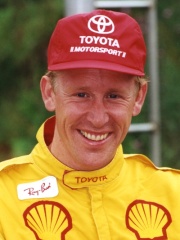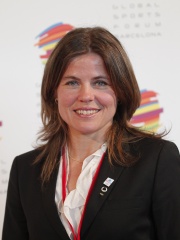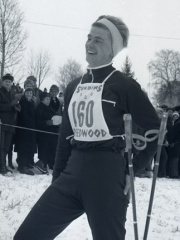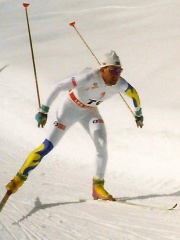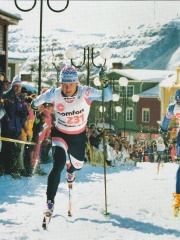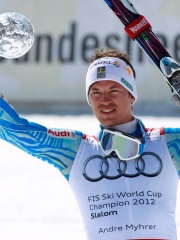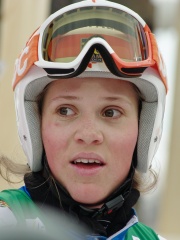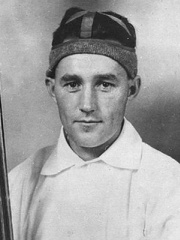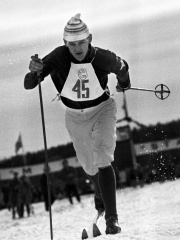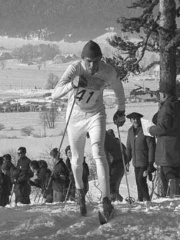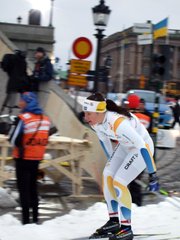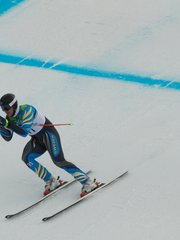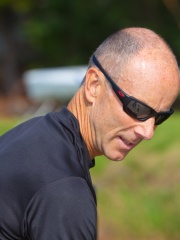
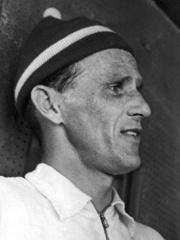
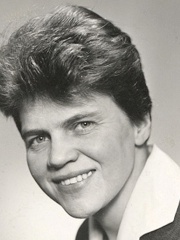
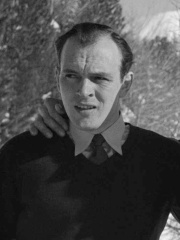
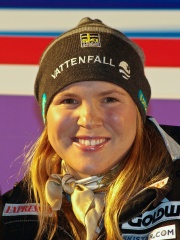
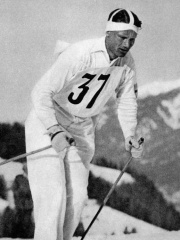
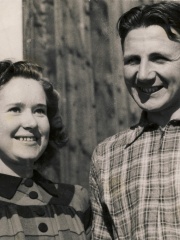
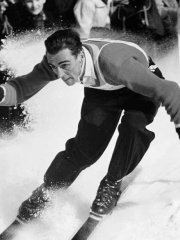
The Most Famous
SKIERS from Sweden
This page contains a list of the greatest Swedish Skiers. The pantheon dataset contains 817 Skiers, 62 of which were born in Sweden. This makes Sweden the birth place of the 5th most number of Skiers behind Germany, and Switzerland.
Top 10
The following people are considered by Pantheon to be the top 10 most legendary Swedish Skiers of all time. This list of famous Swedish Skiers is sorted by HPI (Historical Popularity Index), a metric that aggregates information on a biography's online popularity. Visit the rankings page to view the entire list of Swedish Skiers.

1. Ingemar Stenmark (b. 1956)
With an HPI of 69.45, Ingemar Stenmark is the most famous Swedish Skier. His biography has been translated into 48 different languages on wikipedia.
Jan Ingemar Stenmark (Swedish pronunciation: [ˈɪ̌ŋː(ɛ)mar ˈstêːnmark]; born 18 March 1956) is a Swedish former World Cup alpine ski racer. He is regarded as a legendary skier and one of the most prominent Swedish athletes ever, having won several Olympic medals and world cups during his career. When he retired in 1989, he held the record for the greatest number of international race wins, a record that was only broken in 2023 by Mikaela Shiffrin and remains unbroken amongst men. He competed for Tärna IK Fjällvinden.

2. Sixten Jernberg (1929 - 2012)
With an HPI of 61.56, Sixten Jernberg is the 2nd most famous Swedish Skier. His biography has been translated into 30 different languages.
Edy Sixten Jernberg, known as "Sixten", (6 February 1929 – 14 July 2012) was a Swedish cross-country skier and one of the most successful cross-country skiers of all time. Between 1952 and 1964 he took part in 363 ski races, finishing within the podium in 263 and winning 134 of them; during this period he won four world titles and nine Olympic medals. In 12 starts over three consecutive Winter Games he never finished worse than fifth place, and between 1955 and 1960, he won 86 out of 161 competitions. Jernberg was a blacksmith and a lumberjack before beginning his career as a cross-country skier. He specialized in the longer distances, with four of his eight gold medals coming over 50 km, one over 30 km and three in the 4 × 10 km relay. He also won Vasaloppet twice, 1955 and 1960. He won the 15 km at the Holmenkollen ski festival in 1954. At one competition, Jernberg had a fever and coughed up blood, but still finished the 50 km event. Gunde Svan said: "It was almost like [Sixten] didn't like his own body and tried to punish it in different ways." For his cross-country skiing successes, Jernberg was awarded the Holmenkollen medal in 1960 (shared with Helmut Recknagel, Sverre Stensheim and Tormod Knutsen). He was also awarded the Svenska Dagbladet Gold Medal in 1956 (shared with pentathlete Lars Hall). Jernberg retired after the Olympic Winter Games of 1964. In 1965, the International Olympic Committee awarded Jernberg the Mohammed Taher Trophy for his contributions to Nordic skiing. He died of stroke at the age of 83. His nephew Ingemar became an Olympic pole vaulter.

3. Sonja Edström (1930 - 2020)
With an HPI of 59.92, Sonja Edström is the 3rd most famous Swedish Skier. Her biography has been translated into 22 different languages.
Sonja Viola Edström-Ruthström (Edström before 1960, 18 November 1930 – 15 October 2020) was a Swedish cross-country skier. She competed at the 1952, 1956, and 1960 Olympics in the 10 km and 3 × 5 km relay events and won bronze medals in both in 1956; in 1960 she finished fifth in the 10 km, but won the 3 × 5 km relay. Edström also won two 3 × 5 km relay bronze medals at the FIS Nordic World Ski Championships in 1954 and 1958. She won the 10 km event at the Holmenkollen ski festival in 1956. In 1953–1960, she collected 12 individual and three relay national titles. Edström was born in a family of six siblings, and was mostly raised by her father, as her mother fell seriously ill when Edström was six years old. At 14 she started working as a maid, and at 16 as a bottles cleaner at the Luleå Brewery. She was later a nurse at a Luleå hospital for more than 30 years.

4. Gunnar Eriksson (1921 - 1982)
With an HPI of 58.99, Gunnar Eriksson is the 4th most famous Swedish Skier. His biography has been translated into 20 different languages.
Krång Erik Gunnar Eriksson (13 September 1921 – 8 July 1982) was a Swedish cross-country skier who won two medals at the 1948 Winter Olympics, a gold in the 4 × 10 km relay and a bronze in the individual 18 km. Eriksson won the 50 km event at the 1950 FIS Nordic World Ski Championships, but finished 12th at the 1952 Olympics and 21st at the 1954 World Championships. Eriksson had five brothers and three sisters. Their father died aged 42, and the children had to start working in their teens at the local knife factory; in 1946 they started their own hardware business. Eriksson married Kerstin Norlin, the winner of the 1949 Vasa ski marathon, who lived next door. She died aged 38. After retiring from competitions in 1954 Eriksson spent time collecting stamps, fishing, hunting and working as timberjack. In 1980 he developed Lou Gehrig’s disease and died in July 1982.
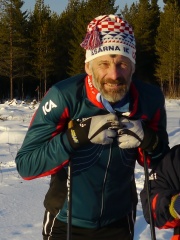
5. Thomas Wassberg (b. 1956)
With an HPI of 57.60, Thomas Wassberg is the 5th most famous Swedish Skier. His biography has been translated into 25 different languages.
Lars Thomas Wassberg (born 27 March 1956) is a Swedish former cross-country skier. A fast skating style – push for every leg – is still called "Wassberg" after him in several countries. Wassberg's skiing idols when growing up were Sixten Jernberg and Oddvar Brå. He has described his mental strength and physical fitness as his greatest abilities as a skier, with his main weakness being a lack of sprinting ability. Wassberg won four Olympic gold medals: in 15 km (1980), 50 km (1984), and the 4 × 10 km relay (1984, 1988), and served as the Olympic flag bearer for Sweden in 1988. At the FIS Nordic World Ski Championships, he earned three golds (50 km: 1982, 30 km: 1987, and 4 × 10 km relay: 1987), three silvers (15 km: 1985, 1987; 50 km (1987), and one bronze (4 × 10 km relay: 1985). Additionally, Wassberg won the 50 km at the Holmenkollen ski festival three times (1980, 1982 and 1987) and the 15 km twice (1979, 1985). At the 1980 Winter Olympics in Lake Placid, Wassberg edged out Finland's Juha Mieto by 0.01 seconds in the 15 km, the closest cross-country ski race in Olympic history. Wassberg subsequently suggested to Mieto that the gold medal should be split between them "as one one-hundredth of a second is nothing in a 15-kilometer race". This incident led the International Ski Federation (FIS) to change their timing to the nearest one-tenth of a second. It also resulted in an apocryphal urban legend that Wassberg and Mieto's medals were cut in half and re-welded into half-gold, half-silver medals. At the 1984 Winter Olympics, Wassberg beat out fellow Swede Gunde Svan by 4.9 seconds in the 50 km, the closest margin of victory ever in that event until Giorgio Di Centa edged out Yevgeny Dementyev by 0.8 seconds at the 2006 Winter Olympics though the 2006 event was a mass start event while the 1984 event was an interval start event. He won the World Cup in 1977, and in 1980 was awarded the Holmenkollen medal. For some reason his teammate Sven-Åke Lundbäck did not receive the Svenska Dagbladet Gold Medal in 1978. In protest to this decision Wassberg refused to accept his Svenska Dagbladet Gold Medal in 1980. According to Bengt Erik Bengtsson, Chief of the Nordic Office of the FIS from 1984 to 2004, Wassberg was the first to suggest in 1984 the splitting of the sport of cross country skiing into classic and freestyle disciplines. This was subsequently implemented by FIS in 1986. After retiring from competitions Wassberg worked as a sports reporter for Swedish Radio and a cross-country skiing coach for his club Åsarna IK. In 2009 he appeared on Swedish television in the show contests Mästarnas mästare, and in 2016 participated in Let's Dance 2016 which was broadcast on TV4. In the 2010s he oversaw the preparation of ski tracks for Åsarna IK, organized bird hunting events for tourists and worked as a forester.

6. Anja Pärson (b. 1981)
With an HPI of 56.22, Anja Pärson is the 6th most famous Swedish Skier. Her biography has been translated into 44 different languages.
Anja Sofia Tess Pärson (Swedish pronunciation: [ˈânːja ˈpæ̌ːʂɔn]; born 25 April 1981) is a Swedish former alpine skier. She is an Olympic gold medalist, seven-time gold medalist at the World Championships, and two-time overall Alpine Skiing World Cup champion. This included winning three gold medals in the 2007 World Championship in her native Sweden. She has won a total of 42 World Cup races.

7. Elis Wiklund (1909 - 1982)
With an HPI of 56.12, Elis Wiklund is the 7th most famous Swedish Skier. His biography has been translated into 16 different languages.
Elis Wiklund (12 December 1909 – 15 March 1982) was a Swedish cross-country skier who won the 50 km race at the 1934 FIS Nordic World Ski Championships and 1936 Winter Olympics. Wiklund won two individual Swedish titles: in the 30 km in 1938 and in the 50 km in 1941. He was an accomplished accordion player, and produced records in 1936. In 1946 he briefly worked as a skiing coach in Switzerland, and after returning opened a sports shop in Sollefteå. Later he became an owner of a ski wax factory. His life was featured in the novel Hjältedrömmen (A Hero’s Dream) by Karl-Erik Johansson.

8. Nils Karlsson (1917 - 2012)
With an HPI of 55.88, Nils Karlsson is the 8th most famous Swedish Skier. His biography has been translated into 20 different languages.
Nils Emanuel Karlsson (25 June 1917 – 16 June 2012), better known as Mora-Nisse, was a Swedish cross-country skier. Karlsson won gold in the 50 km event at the 1948 Winter Olympics and nine Vasaloppet victories.

9. Stig Sollander (1926 - 2019)
With an HPI of 55.48, Stig Sollander is the 9th most famous Swedish Skier. His biography has been translated into 16 different languages.
Stig Oskar Sollander (25 June 1926 – 12 December 2019) was a Swedish alpine skier who competed in the 1948, 1952 and 1956 Winter Olympics. He had his best results in the slalom, finishing fifth in 1952 and winning Sweden's first Olympic medal in alpine skiing, a bronze in 1956. He won another bronze in the combined event at the FIS Alpine World Ski Championships. In 1949, Sollander married Monika Charlotta Sollander; they had six children. Three of them, Stefan, Lena and Lotta, competed nationally in alpine skiing, and Lotta also took part in the 1972 Winter Olympics. Stig died in December 2019 at the age of 93.
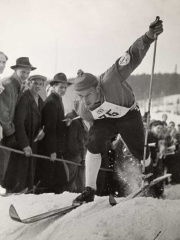
10. Nils Östensson (1918 - 1949)
With an HPI of 55.44, Nils Östensson is the 10th most famous Swedish Skier. His biography has been translated into 17 different languages.
Nils Holger Östensson (29 April 1918, Transtrand, Dalarna – 24 July 1949 at the same place) was a Swedish cross-country skier who competed in the 1940s. He won the 4 × 10 km relay gold and the 18 km silver at the 1948 Winter Olympics in St. Moritz. Östensson also won the 18 km and 50 km events at the Holmenkollen ski festival in 1949. He died in a motorcycle accident on 24 July 1949.
People
Pantheon has 70 people classified as Swedish skiers born between 1901 and 2003. Of these 70, 60 (85.71%) of them are still alive today. The most famous living Swedish skiers include Ingemar Stenmark, Thomas Wassberg, and Anja Pärson. The most famous deceased Swedish skiers include Sixten Jernberg, Sonja Edström, and Gunnar Eriksson. As of April 2024, 9 new Swedish skiers have been added to Pantheon including Lars-Börje Eriksson, Marie-Helene Östlund, and Jörgen Brink.
Living Swedish Skiers
Go to all RankingsIngemar Stenmark
1956 - Present
HPI: 69.45
Thomas Wassberg
1956 - Present
HPI: 57.60
Anja Pärson
1981 - Present
HPI: 56.22
Gunde Svan
1962 - Present
HPI: 54.83
Jan Boklöv
1966 - Present
HPI: 54.76
Pernilla Wiberg
1970 - Present
HPI: 54.26
Barbro Martinsson
1935 - Present
HPI: 53.85
Torgny Mogren
1963 - Present
HPI: 49.58
Benny Kohlberg
1954 - Present
HPI: 48.28
Jan Ottosson
1960 - Present
HPI: 47.51
André Myhrer
1983 - Present
HPI: 46.47
Sara Hector
1992 - Present
HPI: 46.23
Deceased Swedish Skiers
Go to all RankingsSixten Jernberg
1929 - 2012
HPI: 61.56
Sonja Edström
1930 - 2020
HPI: 59.92
Gunnar Eriksson
1921 - 1982
HPI: 58.99
Elis Wiklund
1909 - 1982
HPI: 56.12
Nils Karlsson
1917 - 2012
HPI: 55.88
Stig Sollander
1926 - 2019
HPI: 55.48
Nils Östensson
1918 - 1949
HPI: 55.44
Sven Utterström
1901 - 1979
HPI: 54.86
Assar Rönnlund
1935 - 2011
HPI: 53.64
Jan Halvarsson
1942 - 2020
HPI: 52.51
Newly Added Swedish Skiers (2025)
Go to all RankingsLars-Börje Eriksson
1966 - Present
HPI: 46.08
Marie-Helene Östlund
1966 - Present
HPI: 41.79
Jörgen Brink
1974 - Present
HPI: 39.77
Anna Swenn-Larsson
1991 - Present
HPI: 37.44
Britta Johansson Norgren
1983 - Present
HPI: 37.40
Hans Olsson
1984 - Present
HPI: 36.06
Emma Aicher
2003 - Present
HPI: 34.97
Hanna Erikson
1990 - Present
HPI: 34.55
Oskar Svensson
1995 - Present
HPI: 32.78
Overlapping Lives
Which Skiers were alive at the same time? This visualization shows the lifespans of the 8 most globally memorable Skiers since 1700.

